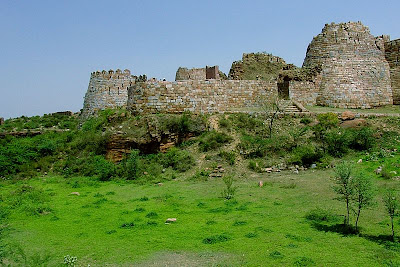Constructed By: Ghiyas-ud-Din Tughlaq
Year of Construction: 1321-25
Location: Near Qutab Minar Complex, on the Qutab-Badarpur Road
In a state of total ruin, the Tughlaqabad fort was once a symbolic of the might of the Tughlaq dynasty. The Tughlaqabad fort was built by Ghiyas-ud-din Tughlaq, the founder of the Tughlaq dynasty. The fort is spread over an extensive area and a piece of architectural marvel. Ghiyas-ud-din Tughlaq built the Tughlaqabad fort as part of Tughlaqabad, the third city of Delhi. This was the period of political unrest and there was continuous danger of Mongol attack from the North western borders of the Empire. To save the Empire and his subjects from the marauding Mongols, Ghiyas-ud-din built the Tughlaqabad fort.
Even though the fort is in a state of ruins, it bears testimony to past glory and might of the Delhi Sultanate. The massive ramparts, battlements and the mammoth stonework of Tughlaqabad fort speak highly of the architectural skills and advancement of the craftsmen. The Tughlaqabad fort served twin purpose of a defensive structure as well as the imperial capital of Ghiyas-ud-din Tughlaq. There are a number of monuments within the precincts of this massive fort.
The Tughlaqabad fort was completed in a short period of four years (1321-25). The fort's massive ramparts and bastions (as high as 15-30 m, built of enormous blocks of stone and walls 10 m thick in places) speak volumes about the might of the Sultanate. Within fort's high walls, double-storied bastions and massive towers were housed magnificent palaces, grand mosques and audience halls. The city lay on the eastern outskirts of the massive fort. On the southern side of the fort is the tomb of Ghiyas-ud-din Tughlaq, which was built by the ruler himself. The tomb is enclosed in a courtyard with fortified walls and a fine example of Indo-Islamic architecture.


